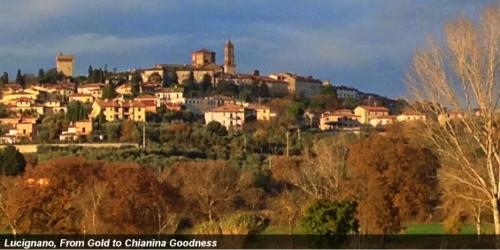Il piccolo borgo di Lucignano, situato sulle colline toscane tra Siena ed Arezzo costituisce uno degli esempi più straordinari di urbanistica medievale per il suo impianto a forma ellittica ad anelli concentrici, pervenutoci intatto attraverso i secoli. Il cuore del paese è la piazza del Tribunale, sulla quale si affacciano la Chiesa di S. Francesco, la Collegiata ed il duecentesco Palazzo Comunale che ospita il Museo. Al suo interno sono custodite opere d’arte del Medioevo e del Rinascimento toscano, fra le quali spicca il magnifico Albero d’Oro, un’attrazione per i turisti di tutto il mondo. A maggio il borgo si colora e profuma con i fiori della Maggiolata, una festa che rievoca le antiche celebrazioni popolari per festeggiare l’arrivo della bella stagione. Ciascuno dei quattro rioni del borgo costruisce carri interamente ricoperti di fiori che sfilano per le vie del paese accompagnati da carri agricoli e da gruppi folkloristici. Immancabile, in qualsiasi ristorante di Lucignano, il miglior cibo della cucina tradizionale toscana.
The tall medieval watchtowers on Lucignano’s main piazza are testament to its bellicose history: ferocious battles raged when nearby Arezzo, Siena, Perugia, and Florence vied for dominance of this hill town perched above the fertile Valdichiana valley stretched out below. Located in Tuscany, about 40 miles southeast of Florence, Lucignano’s urban street plan is typical of a fortified town. The Sienese built the first ring of walls in the 14th century and the conquering Medici added theirs over a century later. The concentric circles of looping alleyways are quiet now.
In Lucignano one can discover its heart of gold. In its Museo Civico, you’ll find the “L’albero della vita” (“The Tree of Life” or “The Golden Tree”). Visitors often view the stunning reliquary in flabbergasted silence; over seven feet of gilded bronze, embossed silver, enameled parchments, and coral branches interlaced in an intricate masterpiece of 14th and 15th century Sienese and Arezzo area goldsmiths.
And, Lucignano hides other delights, too – like the food. Strolling the backstreets, we stopped in at the local macelleria where the butcher, Gilberto, sliced up the prized bistecche alla fiorentina. After all, this is the Valdichiana area, homeland of the famous massive white oxen, la Chianina. The so-called “Florentine steaks” can only be of Chianina beef.
By this time, we were on “the Chianina trail” so Gilberto suggested the Ristorante la Maggiolata, just up the road, where hosts Fabrizio and Francesca cook up and serve Chianina goodness (Gilberto provides the meats). Our feast did not disappoint!
Whether you head to Lucignano for the golden reliquary splendor – or for the Chianina – be sure to include it in your southern Tuscany explorations. You’ll strike gold.
-
 Luciagnano, From Gold...
Luciagnano, From Gold...
Luciagnano, From Gold...
Luciagnano, From Gold...
-
 L’albero della vita,...
L’albero della vita,...
L’albero della vita,...
L’albero della vita,...
-
 Pino and Gilberto...
Pino and Gilberto...
Pino and Gilberto...
Pino and Gilberto...
https://www.lagazzettaitaliana.com/region-of-italy/8123-lucignano-from-gold-to-chianina-goodness#sigProId47cc1c41ad



